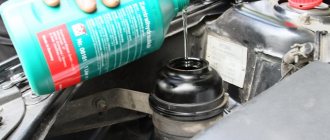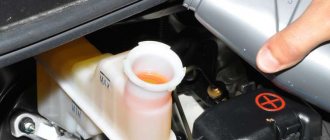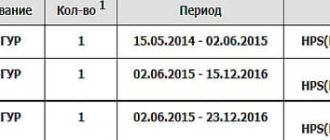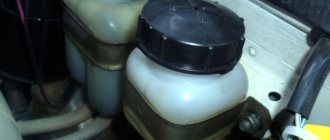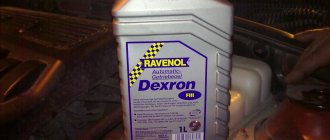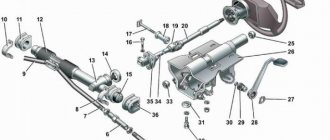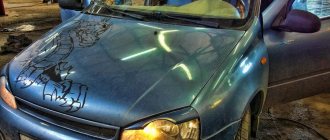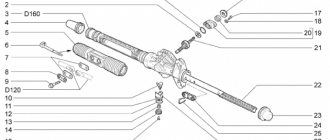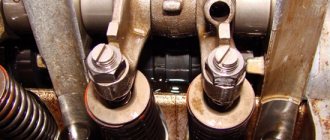In 2002, the manufacturer GM-AvtoVAZ began serial production of the Chevrolet Niva. This model is a replacement for the old Niva, but it retains all the advantages of the first one, namely the presence of permanent all-wheel drive, a locked center differential, as well as a two-speed manual gearbox. The car belongs to the SUV class and has 6 trim levels, namely: L, LC, LE, GL, GLC and LE+. The latest configuration was introduced in 2015. It differs from the rest in that it contains such elements as air conditioning, a full safety package, Continental Cross Contact tires, K&K Camelot wheels, special rear bumper protection, a towbar, as well as unpainted moldings.
From 2002 to 2009, the Chevrolet Niva was produced with the same design, and later a restyling was carried out, during which some elements of the car were changed. In 2015, models with modernized engines that complied with the Euro-5 standard appeared on the assembly line, when previously a four-cylinder unit with a displacement of 1.7 liters and a maximum power of 5.8.5 kilowatts or 79.5 horsepower was installed. The engine is paired with a five-speed manual gearbox. To make driving easier, the manufacturer equipped the car with a hydraulic power steering mechanism. Serial production of the second generation is planned for 2022.
changing the oil in a gur sheviniva - logbook of the 2009 Chevrolet Niva L on DRIVE2
I forgot to take a camera and take a picture of how it was and what happened. And it’s -15 outside. So I didn’t like the condition of the thick hose, all cracked, and I decided to replace it. At the same time, I need to change the oil because Neither I nor the old owner know what kind of oil was poured in there (apparently it hasn’t been changed from the factory), but the color is green. After reading the forums, I decided to take the red SHELL DONAX. I drained the old one, changed the reservoir for a new one (since there is a filter there, I decided to be on the safe side and replace it), filled in new oil, pumped it out. The old one looks darkish but without impurities. One minus is that you need to bleed the air, but I don’t know where this valve is. I’ll look for it. I bleed the air through the open tank cap. I hope nothing breaks))) ah Yes, for some reason the book says that the oil volume in the power steering is 1.7, but I got 1.3 and the old one came out of the system. The level in the tank is still there. The steering wheel is turned in all directions, everything works fine. There is no more hissing when the steering wheel is all the way to the side (but this may be due to the tank cap) I’ll keep an eye on what might change. Oil-480 for 1l hose 16-1m 140r tank-350r
Mileage: 33346 km
www.drive2.ru
Device
The Niva Chevrolet power steering makes work easier; when you turn the steering wheel, the hydraulic drive turns on, thanks to which additional force is created, and the steering wheel can be turned without any difficulty. It consists of the following elements:
- Liquid tank. Made from high-strength plastic. Contains fluid to operate the amplifier.
- Pump. It is a key element of the system, runs on an engine and is driven by a belt drive. It contains oil that is supplied due to the resulting pressure, it is several times higher than atmospheric pressure.
- Valve system. It has a rotary valve that opens when the steering wheel is turned.
- Steering rack. This is an ordinary rack that has hydraulic lines, thanks to which movement occurs.
Below is a diagram of the location of these components:
What tools for preparation
Special tools do not require changing the oil in the power amplifier. One key number 10. Fixed screwdriver. And a container for liquid that will drain. Due to the tightness of the engine compartment, it is best to take a cut plastic bottle. Well, the process itself First, release the clamping cup clamp from the key. Wipe it gently with a cloth. It is necessary that dirt accidentally gets into the tank. Only then carefully unscrew the tank cap using the level indicator. Carefully pour the liquid into the bowl. Using a screwdriver, loosen the hose clamp from the power steering to the tank. This is a drain hose. Hole in tank, connection to remote hose, plug. The hose itself is directed into a container to drain the liquid.
Rotary valve
High pressure in the line must be controlled, otherwise the fluid will exert force in only one direction. A rotary valve is used to distribute the liquid along the line. To be more precise, there are several of them. When the steering wheel is turned, the valve opens that part of the line that corresponds to the given direction of movement of the rack rod. Usually, throughout the entire period of operation, the valve does not cause any problems, but for this it is necessary to periodically change the power steering fluid according to the established regulations, otherwise the valve may become clogged.
The design of the Niva Chevrolet steering linkage and its features
The Chevy Niva steering linkage is a movable structure of interconnected elements. The main components are:
- Bipod;
- Pendulum arm (steering pendulum);
- Medium thrust;
- Lateral thrust (right and left);
- Steering knuckles.
A bipod is nothing more than an all-metal lever that is mounted on the steering shaft. The left tie rod is pivotally attached to the end of the lever. The middle link serves to transfer force to the right wheel.
For it, the second support point is the steering pendulum, movably mounted in a special bracket. This pendulum plays the role of a second lever, transmitting force to the right steering rod. Steering knuckles do not belong to the trapezoid, but are often considered as part of the steering system and allow a more detailed description of the process of driving a car.
On Shevik, the side rods consist of two parts. They are connected to each other by a split coupling, which has internal left and right threads on different sides. When the clutch rotates, both parts of the side rod converge or diverge, changing the distance from the bipod or pendulum to the steering knuckle. Thus, it is possible to set a certain wheel toe angle. Typically, the part of the side rod that faces the wheel is called the tie rod end.
Absolutely all Niva Chevrolet trapezoid rods have hinges at the ends. The hinge pins are designed for a conical fit and are tightened with nuts when connected. Hinges allow the trapezoid parts to remain movable relative to each other and relative to the car body. Some car enthusiasts are inclined to believe that the elements of the Shevik steering linkage are suitable for the classic Niva and vice versa.
To describe the operation of the entire vehicle control system, it is enough to indicate the main directions of force transmission from the steering wheel. By means of a worm gear, the rotation of the shaft with a gain in force is converted into rotation of the steering bipod. It is simultaneously connected to the left and middle rods. An analogue of a bipod is a pendulum that can rotate freely in the bracket.
When a car turns, the wheels describe a circle of different radii. Provided that the angular velocity on the axle is the same, one wheel will certainly slip. This leads to increased tire wear and poor handling. The solution to the problem comes down to the fact that during a maneuver the steering knuckles must turn at different angles relative to the straight line of motion of the car.
This ratio can be ensured by correct selection of the inclination of the levers, as well as their length. If it is not possible to completely eliminate slipping, then it is necessary to reduce it to a minimum. The wheel alignment angle must be adjusted after any repair work on the trapezoid. It is especially often necessary to change the steering tip, and it is recommended to replace it on both sides at once.
And also interesting: Tuning the interior of a VAZ 2121 - improving the Niva with your own hands Video
Features of operating a Chevrolet Niva car affect the condition of the trapezium elements, so it is important to periodically carry out diagnostics. In order not to lead to the failure of the linkage joints, it is necessary to check the integrity of the protective covers. During the inspection, attention is paid to the presence of cotter pins on the hinge pins, and the absence of deformation or damage to the rods is also checked.
Steering gear
The steering mechanism performs two functions simultaneously. First, it converts steering wheel rotation force into bipod rotation force. In essence, the rotation axes rotate. Hydraulic fluid transmits force to a power cylinder connected to the bipod sector. The most common malfunction of the mechanism is associated with a leak in the high pressure line connection fitting. Typically, repairs come down to replacing the fitting along with the main hose.
The power steering can serve properly for a long time.
Previous posts from the category: NIVA CHEVROLLE
How to change the cylinder block gasket on a Chevrolet Niva
Fuel pump design The Chevrolet Niva fuel pump is located in a gas tank and is combined into a common module with a fuel pressure regulator and a gasoline level indicator. The electric submersible pump has a commutator motor.
Changing the chain tensioner on a Chevrolet Niva
Hydraulic Chain Tensioner The chain tensioner is one of the parts of the gas distribution system that relates to the engine camshaft. It is located in front of the “head” of the cylinder block under the cooling system nozzle.
Selecting oil for filling into the power steering for a Chevrolet Niva
Hydraulic fluid in a Chevrolet Niva is oil that transmits resistance from the pump to the hydraulic cylinder. This mechanism makes it easier to turn the steering wheel. In addition, the product lubricates car parts and prevents them from wearing out.
Oil circulation through the power steering system occurs through connecting units and hoses. The mixture level is indicated on the expansion tank with MIN and MAX marks. So every motorist should monitor the amount of oil and add it in a timely manner. Otherwise, the system will fail, and its repair will be expensive.
Driving a vehicle without hydraulic fluid will damage the pump, which is an expensive part. As a result, the power steering mechanism will not be able to work. If the Chevrolet Aveo is left without oil in the power steering system, you need to call a tow truck.
If the power steering fails, it is possible to drive the car, but the steering wheel will be difficult to turn.
Driving without hydraulic booster mixture puts you at risk of breaking the pump, which costs a lot of money, as it will run dry. As a result, the part fails prematurely.
Removal
Over time, the power steering wears out or breaks, so it needs to be replaced, but to do this it needs to be removed, this can be done as follows:
- The first step is to remove the belt that drives the power steering, as well as the protection of the pan with mud flaps of the engine compartment.
- We pump out all the liquid from the tank
- We take a screwdriver and stop the pulley, loosen the bolts that secure it to the flange
- Unscrew all the bolts and remove the pulley
- Drain the remaining liquid
- Disconnect the hose
- Unscrew the bolt fitting
- Seal the hose tip with a special washer
- We unscrew all the existing fasteners, including the top bolt, and remove the pump.
After the pump is removed, it can be repaired.
Bleeding the power steering system
To bleed the power steering system on a Niva, you need to set the steering wheel to the middle position and start the engine for a few seconds without turning the steering wheel. After this, you need to turn off the car and turn the steering wheel all the way in any direction.
Then the protective cap is removed from the special valve and, using a wrench, it is turned to bleed any remaining air from the system.
Then you need to turn the steering wheel in the other direction, leaving the air bleed valve open. An air plug and some liquid will come out of it, after which the valve must be closed. If necessary, the mixture is added to the power steering to the maximum mark. Then you need to start the engine and turn the wheel from side to side until it stops. This must be done until air bubbles stop escaping into the tank. If necessary, the mixture is topped up again to the required level.
